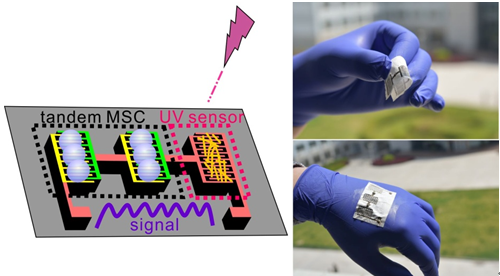[China Instrument Network Instrument Development] Flexible sensors can be worn or implanted in the human body and can detect surrounding environmental information and receive extensive attention in the medical and health field.

Paper-based self-powered sensor integrated schematic and physical map
However, sensors that are used as electrical devices cannot work on their own and require a power supply to power them. Planar micro-supercapacitors (MSC) as a new type of micro-electrochemical energy storage devices can be easily integrated with sensors or other electronic devices. The general method is to connect the sensor and the power supply through an external wire, but it causes inconvenience in the flexible wearable technology. How to integrate flexible and wireless power and sensors into the same chip is a challenge for the current research institute.
Paper materials are low in cost, ready to use, and have a porous and rough fiber structure that can enhance their bonding with electronic devices. The capillary effect caused by the pores of cellulose causes the ink material printed by the printing technique to spread on the surface of the paper base, resulting in poor quality of the formed pattern. Lan Xingbin, a researcher at the Laboratory of Clean Energy Chemistry and Materials, Lanzhou Institute of Chemical Physics, Chinese Academy of Sciences, used screen printing technology to form a metallic Ni-digitated finger current collector on the surface of filter paper, combined with subsequent electroplating techniques to enhance the conductivity of the current collector and suppress The diffusion of metallic Ni on the surface of the paper base forms a patterned collector with high resolution. Electrochemical deposition of MnO2 or polypyrrole (PPy) active material on the Ni surface and the gel electrolyte was applied dropwise to form a symmetric supercapacitor based on MnO2 and an asymmetric supercapacitor based on MnO2 and PPy. Tests have shown that the paper-based supercapacitor has good electrochemical characteristics and strong resistance to mechanical deformation (the capacity is almost not degraded after bending 10,000 times), and its energy density and power density are all in the same type of supercapacitor. Forefront.
Based on metal integrated circuits printed on paper, the researchers integrated MSC and UV sensors or gas sensors on the same single sheet, and the integrated devices showed good sensing characteristics and self-powered characteristics. The future is expected to integrate energy harvesting, energy storage, and consumer devices into the same paper-based chip. This paper-based integration strategy opens up new design methods for portable and wearable electronics.
The study was published online on Advanced Functional Materials. The research work was funded and supported by the "135" Key Cultivation Project of the National Natural Science Foundation of China.
(Original Title: Research Progress of Flexible Paper-Based Integrated Devices Made by Lanzhou Institute of Materials)
![<?echo $_SERVER['SERVER_NAME'];?>](/template/twentyseventeen/skin/images/header.jpg)